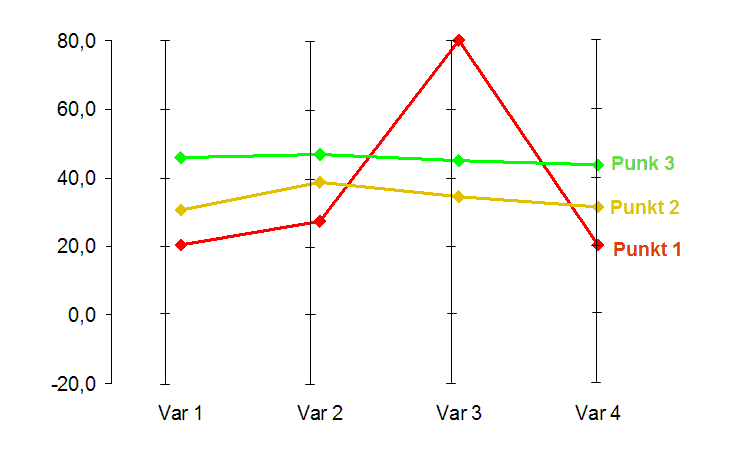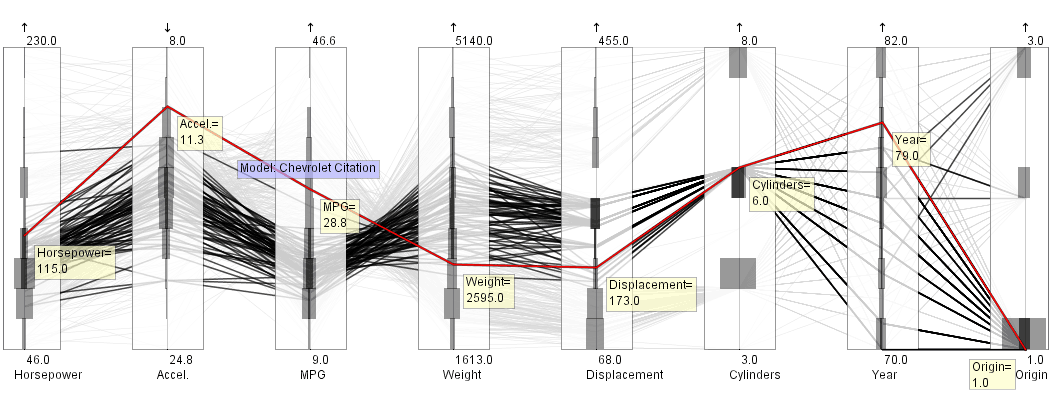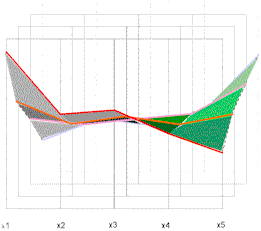Teaching:TUW - UE InfoVis WS 2008/09 - Gruppe 02 - Aufgabe 1 - Parallel Coordinates
Parallel coordinates is a common way of visualizing high-dimensional geometry and analyzing multivariate data.
Revealed Information
When visualizing multidimensional datasets with common coordinate systems human cognition is limited to few dimensions [IEEE, 1990]. The fourth dimension in 3d-diagramms can be visualized by using different colors, point-sizes or shapes. But this technique does not always point out the features you are interested in.
Parallel coordinates enable displaying multi dimensional datasets in coordinate systems by placing each dimension on its own axis and arranging these axes parallel to each other. Each point is put on the accordant axis; lines are drawn to connect related data points [Scienceblogs, 2008].
The figure to the left shows three points with four dimensions in a parallel coordinate system. [Scienceblogs, 2008]

As this figure demonstrates distinctive features can be easily found using this technique.
Example
Another example of usage of this kind of diagrams is when evaluating automobiles: the different axis could be the horsepower, acceleration, the weight, etc. The lines crossing the axes represent the values corresponding to a particular car model [infovis.net], [vrvis.at].

Extruded Parallel Coordinates
An extension of Parallel Coordinates are Extruded Parallel Coordinates. For each dataset a new set of axis is created and shifted along the z-axis. In interactive environments a clearly overview can be given by drawing planes between polylines of two different datasets [CG2, 1997].

References
- [IEEE, 1990] A. Inselberg, B. Dimsdale, Parallel coordinates: a tool for visualizing multi-dimensionalgeometry. Published at Oct 23-26, 1990. Retrieved at Nov 2, 2008. http://ieeexplore.ieee.org/xpl/freeabs_all.jsp?arnumber=146402
- [CG1, 1997] Günter Rubik, Parallele Koordinaten. Created at June 27, 1997. Retrieved at Nov 2, 2008. http://www.cg.tuwien.ac.at/~rubik/paracord.htm.
- [CG2, 1997] Günter Rubik, Extruded Parallel Coordinates. Created at July 19, 1997. Retrieved at Nov 2, 2008. http://www.cg.tuwien.ac.at/~rubik/extruded.htm
- [Scienceblogs, 2008] Jörg Blumtritt, Parallelkoordinaten. Created at Feb 28, 2008. Retrieved at Nov 2, 2008. http://www.scienceblogs.de/zahlenbilder/2008/02/parallelkoordinaten.php
- [Wikipedia] Retrieved at Nov 2, 2008. http://en.wikipedia.org/wiki/Parallel_coordinates
- [infovis.net] Juan C. Dürsteler, Visualisation in the 20th century. Retrieved at Nov 2, 2008. http://www.infovis.net/printMag.php?lang=2&num=112
- [vrvis.at] Helwig Hauser, Angular Brushing for Extended Parallel Coordinates. Retrieved at Nov 2, 2008. http://www.vrvis.at/via/research/ang-brush/index.html
http://www.scienceblogs.de/zahlenbilder/2008/02/parallelkoordinaten.php